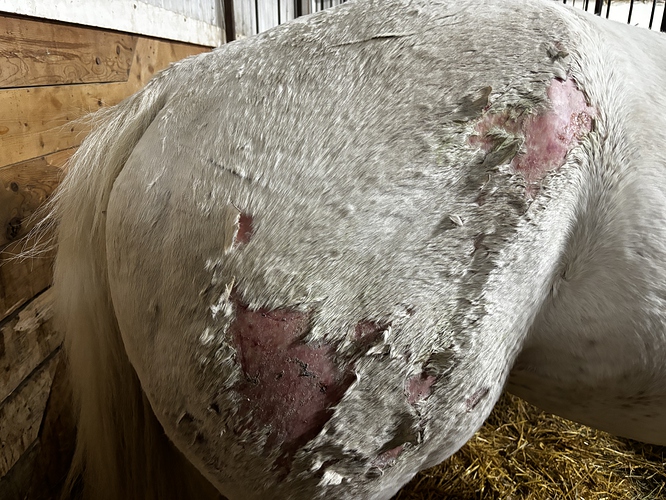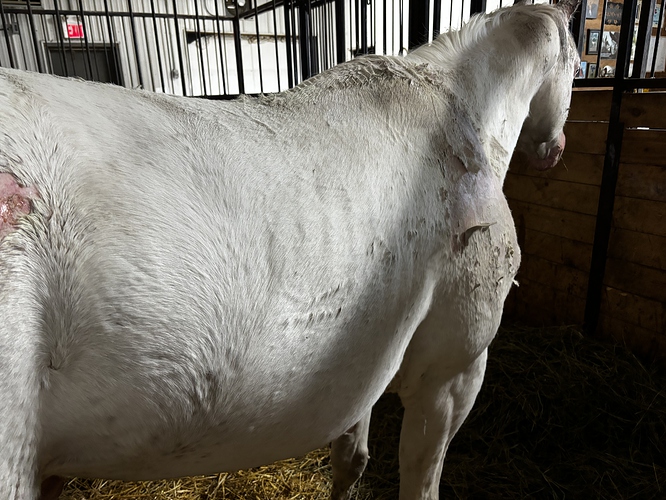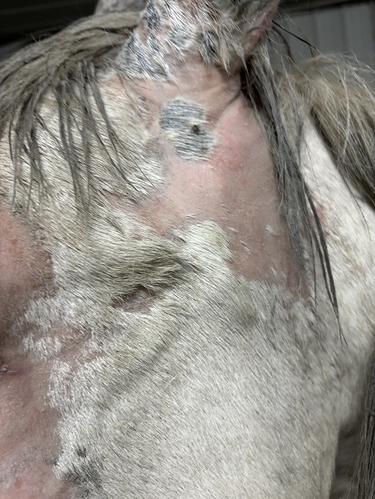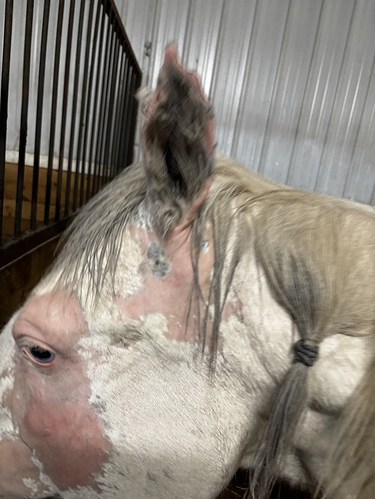That is funny! I never knew horses could burn until I got the mare, my first experience with a horse with lots and lots of white skin on their body.
Actually, my niece was here and saw her and asked curious question: would white skinned horses be at an evolutionary disadvantage given how easily they can burn? If so, what accounts to the number of pintos in the American wild horse population? Genetics and not enough time for that weakness, if it is a weakness, to get weeded out?
That’s a good question, so many issues with being white, burning, being very visible, for two!
He is in full peel mode now, and it’s so hard for a confirmed “picker” not to be pulling bits off him. I go in and he lines himself up fr what needs scratching, nice hard scratches on the bit of his neck and chest that still has good skin, oh so gentle scratches on the bits that obviously itch.
On the plus side, the pink skin on his face has the most adorable peach fuzz coming on, and his appetite has returned with a vengeance, so hopefully this peeling stage will be fairly quick, and they can move into build up mode.
Wild horses are ‘allowed’ to wallow in mud and stay dirty, so maybe not?
My pinto is the only one on a farm full of pintos who burns, so not all are prone to it. Nature may have weeded out most of the wild pintos prone to severe burns from the gene pool.
My poor chestnut mare with three white legs was one of the most prone to severe burns that I’ve seen. We were able to keep her from burning by routinely spraying the fields for weeds but she was absolutely miserable during the summer until we figured it out.
Wild horses also only had to live long enough to breed.
He’s retired now but my big lad has four high whites and a big blaze. His nose burns like mad unless I put sun block on it.
Which is certainly longer than one summer.
I’m aware of that - just saying nature doesn’t select for a long life, just that the animals survive long enough to breed.
Right … but what does that have to do with being white and getting terrible burns? Is a younger horse less susceptible? Not trying to be obtuse*, I just don’t see the link between nature not selecting for a long life and coat colour.
*although possible succeeding despite my best efforts 


I don’t think I quoted properly but I was replying to b_and_b’s post.
As awful as it is, wild horses can (in theory at least) burn and still produce offspring.
Bug spray can cause burns too. Be careful if you mix your own! Ive seen that on necks usually.
Yes! On a short term (Under say 20 generations), the increased likelihood of sunburn is not significant. But it does make me wonder, what about a couple thousand years of breeding? Why do almost all wild animals end up beige/dun/brown? What is up with zebras? Where did the pinto coloration come from anyway? The only true ‘wild’ horse, Prezwalski, is an absolutely constant dun color, why? Where did chrome come from?
All very not important questions!
Gee thanks, another 3 am thought trap for me, where did chrome come from.
Mutations?
I remember reading about some people breeding foxes for fur (not going there) and as they selected tamer foxes to breed new color combinations appeared. IIRC, they were only selecting for ease of handling, no selections based on color.
I remember reading about that. I think it was in Russia? Something like the tamer the future generations became the more white patches they had on them
yes
Here’s the article.
I’m open to correction if this is wrong, but domestication also shrinks the gene pool bc the breeding is more selective for certain desired traits, but also allows individuals to reproduce that might not in the wild. The “wild type” animals may have a recessive gene for Trait A but it never shows up in the wild because it (or is linked to Trait B that) gets the animal killed before they can reproduce. BUT, in domestic breeding, people may like Trait C and can protect the animal to make up for Trait B, thereby making Trait A more common than it would be in the wild. Breed to right two creatures and TA-DA! Trait A appears. Then people decide they like Trait A and Trait C…
Today’s update, just giggling at his ears, one of the few places he has dark skin patches. You can see how they aren’t shedding, and also the very dark spot that turned out to be a tick.
Poor dude.




